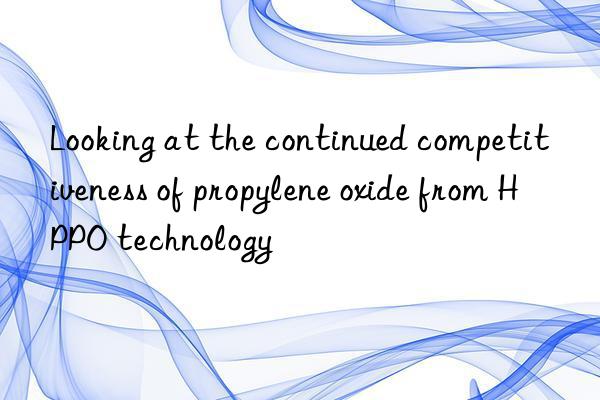
Propylene oxide (PO) is an important propylene derivative and a very important organic compound raw material with broad development prospects.
At present, the main processes for preparing propylene oxide include the chlorohydrin method, the co-oxidation method (PO/SM and PO/TBA) and the direct oxidation method of hydrogen peroxide (HPPO). In 2022, the global production capacity will be more than 16 million tons/year. , the proportions of these processes are 28%, 42% and 28% respectively. The production process of propylene oxide prepared by the chlorohydrin method was the first to achieve industrialization, but it causes serious environmental pollution and is a backward production capacity and is being gradually phased out. The main disadvantage of the co-oxidation method is that it co-produces tert-butyl alcohol or styrene, which is subject to market conditions. At the same time, the equipment cost is high, the construction period is long, the process is complex, and the propylene purity requirements are high.
HPPO is a technology that directly oxidizes propylene with hydrogen peroxide to produce propylene oxide. That is, under low temperature and low pressure conditions, propylene is combined with hydrogen peroxide in a methanol/water mixture, and a selective oxidation reaction occurs in a fixed bed reactor with the help of a special titanium-silicon catalyst. , a green production technology that generates propylene oxide in one step. The characteristics of this technology are short process, simple process, high atom utilization rate, low investment, mild reaction conditions, low energy consumption, basically no pollution, high product yield, and few other by-products. Therefore, it is internationally recognized as a green and environmentally friendly production technology.
Compared with the chlorohydrin method and co-oxidation method, The advantages of HPPO technology are even more obvious. For comparison, with a 10,000 tons/year propylene oxide plant, in terms of investment, including sewage and waste residue treatment, HPPO technology is about 52% of the chlorohydrin method and about 40% of the co-oxidation method; in terms of propylene oxide yield In terms of water, electricity, steam and other public works consumption, HPPO technology has a higher yield than the chlorohydrin method and the co-oxygen method, respectively. The co-oxidation method is 35%-40% lower; the number of public engineering employees is 50 for the HPPO technology, 81 for the chlorohydrin method and 70 for the co-oxidation method; in terms of unit propylene oxide production cost, the HPPO technology is 50 for the chlorohydrin method. 86% and 81.9% of the method and co-oxidation method.
The HPPO method was first successfully developed by the Italian Enichem company in the early 1980s. It reacts propylene and hydrogen peroxide in a methanol solvent to generate propylene oxide and water in the presence of a titanium silicon molecular sieve (TS-1) catalyst. This method has high raw material utilization rate, is green and environmentally friendly, has low investment cost, and represents the development direction of PO production. The core technology of the current HPPO process is mainly in the hands of a very few international chemical giants such as BASF, Dow Chemical, Evonik, and Wood. International giants rely on their monopoly advantages to charge extremely high prices for technology transfer. According to an insider at a large petrochemical company, the technology transfer fee for propylene oxide preparation alone costs tens of millions of euros. Not only that, the hydrogen peroxide manufacturing technology must be bundled and priced separately.
my country's research and development of this process started late. It was not until 2014 that Sinopec Changling Branch built the first domestically developed 100,000 t/a HPPO device with completely independent intellectual property rights, thus breaking through foreign restrictions on this technology. monopoly.
China's per capita GDP is expected to exceed 85,000 yuan in 2025, officially entering the ranks of high-income countries, and its development model will also transform from high growth to high quality. High-quality development is an all-round change. It is a development that changes the economic and social development model from focusing on speed to focusing on quality and efficiency. It involves the improvement of quality and efficiency and the optimization of structure in various fields and industries. Green and sustainable development is the top priority. In China, with the release of the "double carbon" goal and the implementation of related energy conservation and emission reduction policies, green environmental protection has gradually become an important topic for corporate development, and corporate environmental performance has also been pushed to a prominent position.
As environmental protection efforts continue to increase, the chlorohydrin method will gradually withdraw from the stage of history, and the supply gap will be replaced by the greener process HPPO method. It is expected that China's HPPO method's propylene oxide increase will be nearly 2 million tons in the next few years. Mainly from Huayi's 300,000 tons/year HPPO in Qinzhou, Guangxi, Sanyue Chemical's 150,000 tons/year HPPO, Weiyuan's 300,000 tons/year HPPO, Tianchen's 300,000 tons/year HPPO in Quanzhou, and Qixiang Tengda's 300,000 tons/year HPPO. annual HPPO, Dongminxiang Chemical's 150,000 tons/year HPPO unit, and two sets of 400,000 tons/year HPPO units of Satellite Chemical. Among them, satellite chemistry has the most scale advantage. On December 28, 2021, Jiangsu Jiahong New Materials Co., Ltd., a subsidiary of Satellite Chemical, conducted a second environmental impact assessment announcement in Xuwei New District, Lianyungang, Jiangsu. The total investment of the project is 11.38 billion, including 6 sets of 450,000 tons/year peroxide units and 2 sets of 400,000 tons/year propylene oxide units. The propylene oxide plant mainly adopts the hydrogen peroxide direct oxidation process of China Catalyst New Materials Co., Ltd. Following China's largest acrylic acid and ethane cracking production capacity, with the launch of HPPO production capacity, Satellite Chemical will also have China's largest green PO production capacity.



 微信扫一扫打赏
微信扫一扫打赏
